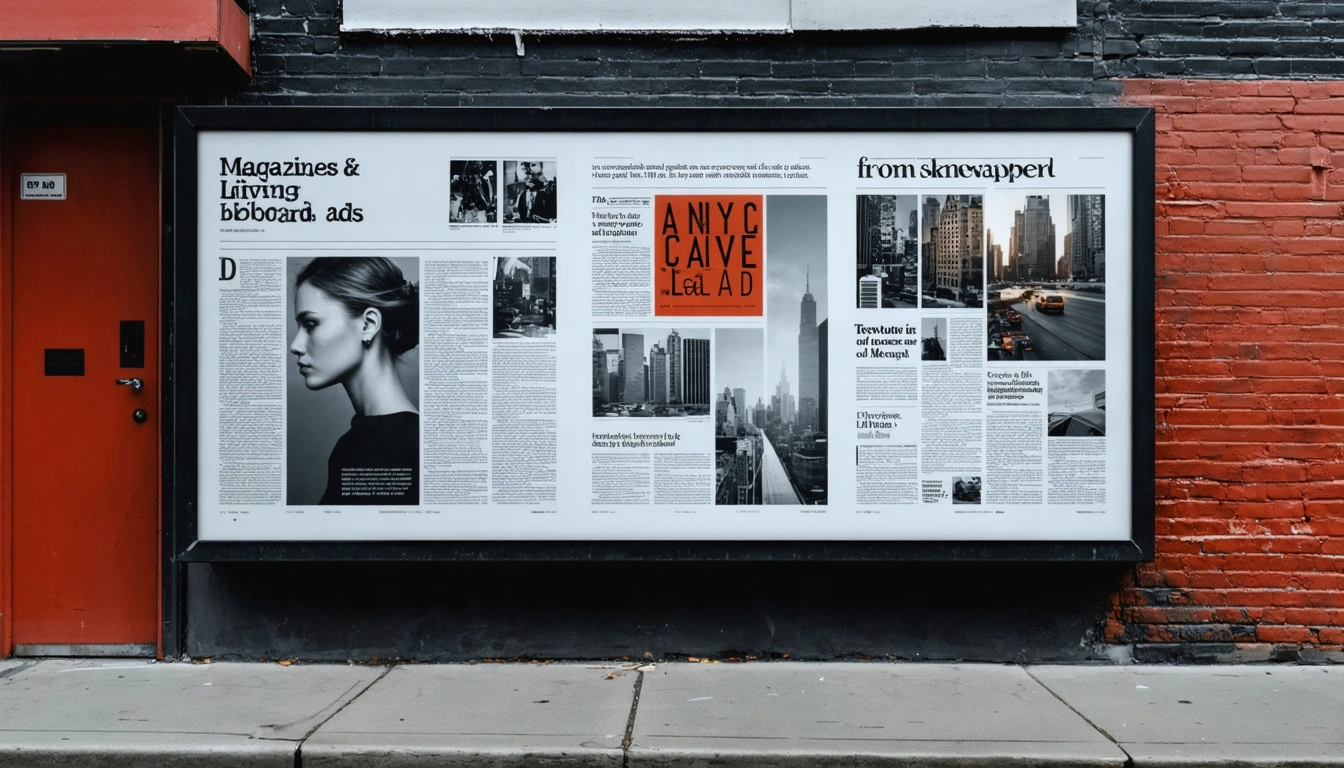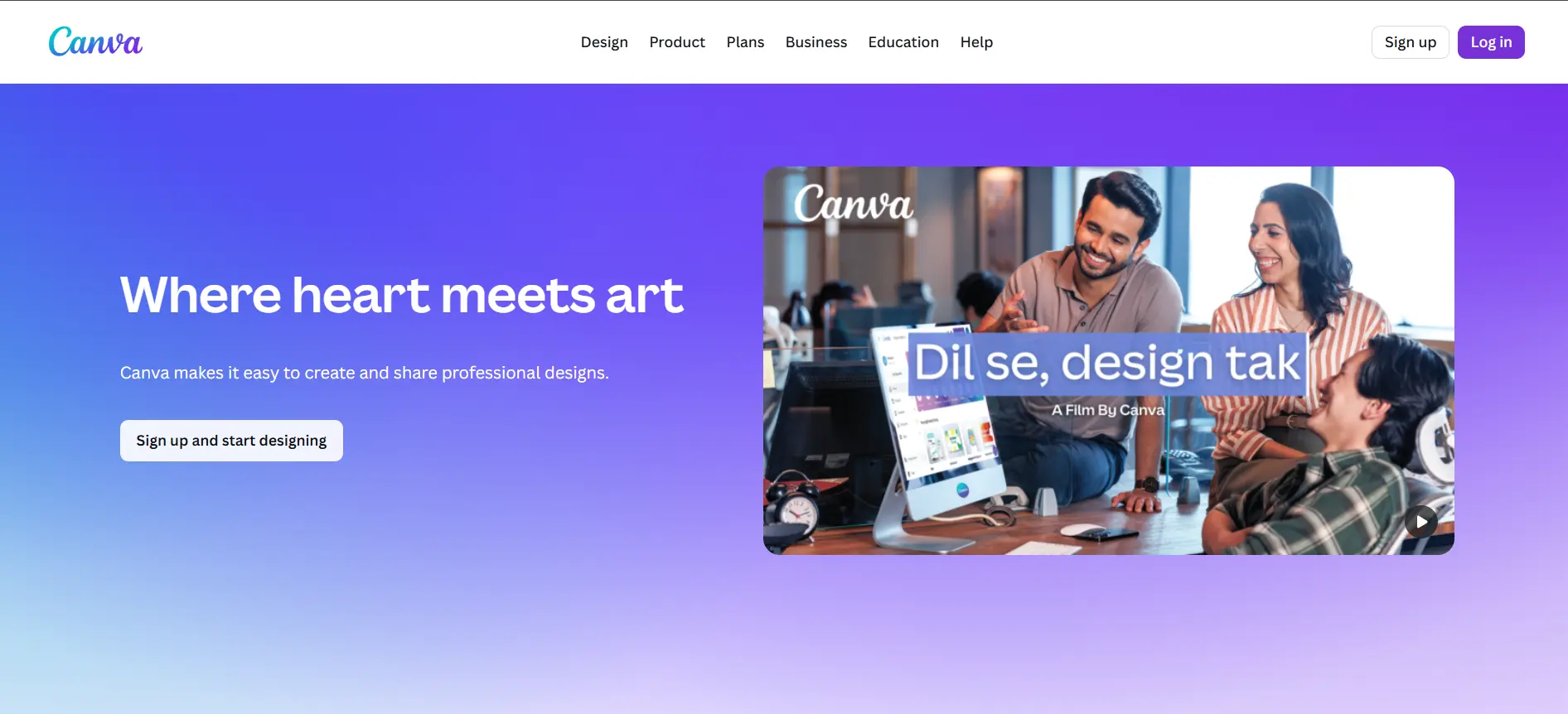Home / Blog / From NYC Billboards to LA Living: How Magazines & Newspaper Ads Still Command Attention in the Digital Age?
In an era dominated by digital screens, the tangible appeal of magazines and newspaper ads continues to captivate audiences across the United States. Imagine sipping coffee in a cozy café in Seattle, flipping through a glossy magazine, or catching a bold headline in a Chicago Tribune while on your morning commute. This blog explores why traditional print media, far from being obsolete, remains a powerful and trusted platform for impactful advertising. We'll dive into how strategic design, compelling storytelling, and city-specific flair can make your brand resonate from the bustling streets of New York City to the relaxed vibes of Los Angeles, proving that sometimes, the oldest tricks are indeed the best.
1 Oct, 2025

1. The Enduring Allure of Ink on Paper in the US
Why do print ads still hold a special place in our hearts, even when our phones are practically glued to our hands? It's the unique sensory experience, the quiet authority, and the perceived trustworthiness that digital often struggles to replicate. Think about it: a vibrant ad in Vogue or a thoughtful spread in The New York Times doesn't compete with pop-ups or auto-play videos; it offers a moment of deliberate engagement. In cities like Boston, commuters often prefer reading a newspaper on their morning train ride, creating a captive and receptive audience. Did you know that consumers reportedly find print ads more trustworthy than digital ads by a margin of 50%? This inherent credibility is gold for brands. "Ink on paper, trust forever!" they say. It’s about building a deeper connection, a bond formed over shared pages rather than fleeting pixels. This connection often leads to higher recall rates; studies show that print ads result in a 20% higher motivation response than digital ads.
• Tangible Experience: The physical act of holding a magazine or newspaper creates a memorable interaction.
• Less Distraction: Readers are typically more focused on print content than online, leading to better ad absorption.
• Perceived Credibility: Print media is often seen as more authoritative and reliable, lending trust to the ads it carries.
2. Crafting Visual Stories: More Than Just an Image
An ad is not just a picture; it's a carefully constructed narrative designed to evoke emotion and inspire action. Whether it’s a luxurious watch ad in a high-end magazine or a compelling local business promotion in a community newspaper in Austin, the visual must speak volumes. This is where expertise in Graphics & Design becomes paramount. Imagine a delicious-looking meal advertised in a food magazine distributed across San Francisco it needs to be so mouth-watering that readers can almost taste it! Poor resolution or an uninspired layout can instantly turn potential customers away. A staggering 75% of consumers admit that high-quality visuals are more important than product descriptions when making purchase decisions. So, investing in stunning imagery and thoughtful design isn’t an option; it's a necessity. "A picture is worth a thousand leads!" jokes one veteran marketer in Miami. What story does your ad tell? Is it compelling enough to make someone pause their morning read in Phoenix?
• Emotional Resonance: Use imagery that connects with your audience's feelings and aspirations.
• Brand Consistency: Ensure your visual style aligns with your overall brand identity.
• High-Quality Production: Crisp, clear, and professional graphics are non-negotiable for print.
3. The Art of the Headline and Copy that Converts
Beyond the visuals, the words you choose are your ad’s secret weapon. A great headline in a national magazine can stop a reader dead in their tracks, much like a catchy jingle on the radio. The copy needs to be concise, persuasive, and relevant, driving home your message with impact. For local newspaper ads in, say, a suburb of Denver, direct and actionable copy often works best. "Don’t just sell; tell a story!" is the mantra. With advancements in AI Services, businesses can now get assistance in generating compelling ad copy and even optimizing headlines for maximum engagement. Imagine leveraging AI to craft a headline that resonates perfectly with the sophisticated readers of a Wall Street Journal insert! Statistics show that a compelling headline can increase ad effectiveness by up to 300%. Poor copy can render even the best visuals useless. It’s like having a beautiful car with no engine – looks great, but goes nowhere!
• Compelling Headlines: Grab attention immediately and communicate value.
• Clear Call-to-Action: Tell readers exactly what you want them to do next.
• Benefit-Oriented Copy: Focus on how your product or service solves a problem for the reader.
4. Targeting Your Audience: From Main Street to Madison Avenue
One of print advertising’s strongest suits is its ability to target specific demographics through specialized publications. Want to reach affluent suburban families in Dallas? Place an ad in a local lifestyle magazine. Aiming for tech-savvy professionals in Silicon Valley? A specific industry journal is your best bet. This granular targeting, often refined with Digital Marketing insights, ensures your message lands in front of the most receptive eyes. Think of the specialized automotive magazines in Detroit versus the fashion glossy in Los Angeles different audiences, different approaches. According to a recent study, highly targeted print ads can achieve up to 70% higher response rates compared to untargeted campaigns. Knowing your audience's reading habits is key. Are they flipping through a morning newspaper in Philadelphia or a niche hobby magazine in Portland? "Target wisely, advertise boldly!" is the mantra for maximum impact.
• Demographic Matching: Select publications whose readership aligns with your target customer.
• Geographic Relevance: Utilize local newspapers and regional magazines for community-specific campaigns.
• Psychographic Profiling: Understand the interests and values of your audience to choose appropriate content.
5. Integrating Print with Digital: A Seamless Journey for US Consumers
The beauty of modern advertising isn't choosing between print and digital, but seamlessly blending them. A well-designed magazine ad can be the perfect gateway to your online presence. Think QR codes that link directly to a specific product page, website URLs, or even calls to download your Mobile App. Imagine a striking ad in a travel magazine inspiring someone in Orlando to scan a QR code leading to a beautifully designed landing page created via expert Web Development. This integrated approach amplifies your message and provides measurable results. Research indicates that campaigns that integrate print and digital see a 40% increase in campaign effectiveness. Don't let your print ad be a dead end! "From page to pixel, convert with vigor!" This synergy creates a powerful, multi-channel customer journey that resonates with today's connected consumers in every major city across the nation.
• QR Codes: Provide instant access to digital content or websites.
• Dedicated Landing Pages: Create specific web pages for print ad campaigns to track conversions.
• Social Media Integration: Encourage readers to follow your brand online for continued engagement.

6. Budget-Friendly Brilliance: Designing on a Dime (or a Million)
Whether you're a burgeoning startup in Portland, Oregon, or a multinational corporation headquartered in Chicago, effective ad design doesn't always require a colossal budget. The key is smart resource allocation and creativity. For smaller businesses, platforms like Canva can be invaluable, allowing for professional-looking designs without the need for expensive software or agencies. "Work smarter, not harder, and let your budget shine!" However, for high-impact campaigns, investing in bespoke design talent can yield significant returns. The average cost-per-impression for newspaper ads, for instance, can be surprisingly competitive, often ranging from $0.05 to $0.10, making it a cost-effective choice for broad reach in local markets. The problem isn't always budget, but knowing how to maximize it. For example, a small local eatery in Atlanta could create a charming, effective ad using affordable tools, proving that creativity trumps expenditure.
• Optimize Ad Size: Smaller, well-designed ads can often be as effective as larger ones for targeted messages.
• Negotiate Placement: Work with publications for better rates or bundled packages.
• Repurpose Content: Adapt existing digital assets for print to save design costs.
7. Measuring Success: Beyond the Eyeball Count in US Print Campaigns
Measuring the ROI of print ads might seem trickier than digital clicks, but it's far from impossible. Clever strategies like unique discount codes, dedicated phone lines, specific landing page URLs (as mentioned before), or even asking "How did you hear about us?" can provide valuable data. Integrating Custom Software solutions for campaign tracking can help centralize data from various channels, including your print efforts. Imagine a specialty retailer in Houston using a unique SKU in their magazine ad, then tracking sales associated with that SKU. This approach helps tie direct sales to print advertising. A study by the Data & Marketing Association found that direct mail (a close cousin to print ads) has an average ROI of 29%, demonstrating its tangible impact. "Track everything, even the ink stains!" It’s about being creative with your attribution models to truly understand what's working across your advertising mix in places like San Diego or New Orleans.
• Unique Tracking Elements: Use specific phone numbers, URLs, or discount codes.
• Post-Campaign Surveys: Gather qualitative feedback on ad recognition and recall.
• Sales Data Analysis: Correlate sales spikes with print ad publication dates.
8. The Future of Print: Innovation and Interactivity
Print is not static; it's evolving! Modern magazines are experimenting with augmented reality (AR) features, allowing readers to scan an ad with their phone and watch a video or interact with a 3D model. Imagine a fashion ad in a New York City magazine where you can virtually "try on" the outfit. This blend of the physical and digital, often incorporating elements of Video & Animation, breathes new life into traditional media. Experts predict that AR integration in print media could grow by 25% annually in the coming years, creating exciting new avenues for brands. "Innovate or evaporate!" is the unofficial motto. For companies in tech hubs like Seattle, exploring these interactive print experiences can position them as forward-thinking leaders, bridging the gap between tangible and immersive experiences.
• Augmented Reality: Embed interactive digital content within print ads.
• Specialty Inks & Papers: Utilize unique printing techniques for tactile and visual appeal.
• Interactive Editorial: Design ads that complement interactive editorial content for deeper engagement.
9. The Psychology of Placement: Where Your Ad Lives
Just like real estate, location matters in advertising. The placement of your ad within a magazine or newspaper can significantly influence its effectiveness. Front covers, inside covers, and right-hand pages generally command higher attention. Understanding reader flow and applying principles of UI/UX design to ad layout helps optimize this. Imagine a vibrant ad for a new Broadway show strategically placed next to a theater review in a New York City publication – perfect synergy! Conversely, an ad buried deep in a less-read section might get lost. Research indicates that ads on right-hand pages typically experience a 15% higher recall rate. "Prime real estate, prime results!" Knowing your publication and its typical layout, whether it's the Washington Post or a regional arts journal in Philadelphia, is crucial for maximizing visibility and ensuring your message truly stands out.
• Premium Placements: Prioritize high-visibility spots like covers or early pages.
• Contextual Relevance: Place ads near editorial content that complements your brand message.
• Readership Flow: Design your ad to fit naturally within the publication's layout and reading patterns.
10. Protecting Your Creative Assets: A Secure Design Journey
In the world of ad design, creative assets high-resolution images, unique fonts, brand guidelines, and final layouts are invaluable. Protecting these requires robust systems. This is particularly true for agencies and brands collaborating across different cities, from a design studio in Los Angeles to a marketing team in Chicago. Utilizing Cloud Computing & Security services ensures that all your critical design files are stored securely, accessible only to authorized personnel, and backed up against any unforeseen disasters. "Secure your creativity, safeguard your brand!" A single data breach or loss of files can derail an entire ad campaign, costing both time and money. For instance, a major brand in Texas managing multiple regional magazine campaigns relies heavily on secure cloud storage to ensure consistent branding and protect proprietary designs. This foresight is critical in maintaining brand integrity and operational efficiency.
• Centralized Storage: Keep all design assets in a single, secure, accessible location.
• Access Control: Implement strict permissions to control who can view, edit, or share files.
• Regular Backups: Ensure all data is routinely backed up to prevent loss from system failures or cyber threats.
Conclusion
In the vibrant advertising landscape of the United States, magazine and newspaper ads design stands as a testament to the enduring power of tangible media. Far from being relics of the past, these platforms offer a unique opportunity for brands to connect deeply and authentically with their audiences. From a local bookstore's charming ad in the San Francisco Chronicle to a luxury brand's captivating spread in a national magazine, print media continues to inform, entertain, and inspire. By embracing innovative design, strategic messaging, and seamless integration with digital channels, businesses can ensure their print campaigns not only capture attention but also drive measurable results. So, next time you're crafting an ad, remember the magic of ink on paper and let your brand's story unfold in a way that truly resonates, whether in the bustling heart of Times Square or the quiet corners of America. Your audience in every US city is waiting to turn the page!
FAQs
1. Are magazine and newspaper ads still effective in today's digital world?
Absolutely! Print ads offer a unique tactile experience and are often perceived as more trustworthy, leading to higher engagement and recall rates among readers, from bustling New York City commuters to relaxed Californians.
2. How can I measure the success of my print ad campaigns in the US?
You can use unique discount codes, dedicated phone numbers, specific URLs, or QR codes that link to trackable landing pages. Many businesses in cities like Dallas also conduct post-campaign surveys to gauge ad recognition.
3. What are the key elements of a successful print ad design?
A successful print ad needs compelling visuals, a strong headline, concise and benefit-oriented copy, a clear call-to-action, and consideration for the publication's target audience, much like a well-crafted billboard in Los Angeles.
4. How do I choose the right publication for my print ad?
Consider your target audience's demographics, interests, and geographic location. For example, a local restaurant in Chicago would benefit more from a community newspaper than a national magazine.
5. Can print ads be integrated with digital marketing efforts?
Yes, definitely! Print ads can feature QR codes or website URLs that drive traffic to online platforms, creating a seamless multi-channel experience that maximizes your reach and impact across the United States.


